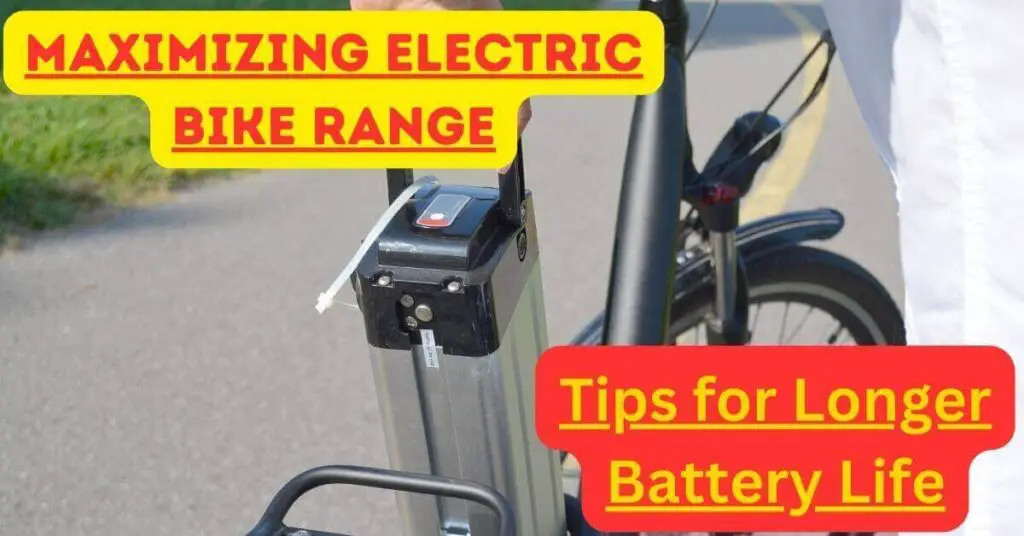
All recommendations within this article are informed by expert editorial opinion. If you click on a link in this story we may earn affiliate revenue.
Introduction
Have you ever been halfway through your cycling route, enjoying the scenic views and the breeze in your hair when suddenly, your e-bike starts to slow down, and you realize the battery is dying?
In the world of sustainable transportation, electric bikes, also known as e-bikes, have become increasingly popular.
They blend the perfect mix of manual cycling and electric assistance, making them ideal for fitness enthusiasts and commuters alike.
But one significant challenge that e-bike owners face is maximizing the bike’s range – how far can you actually go on a single charge?
In this comprehensive guide, we will uncover the secrets of enhancing your electric bike range and ensuring a longer battery life. Buckle up, and let’s dive in!
What is an Electric Bike?

An electric bike, also known as an e-bike, is a bicycle with an integrated electric motor and battery. It offers electric assistance to the rider, which can be either partial or total depending on the bike’s settings.
Some models even come with a throttle, allowing for completely motorised riding. Electric assistance is generally most noticeable when starting up or tackling hills.
Understanding Electric Bike Range

Imagine planning a trip from New York City to Philadelphia.
If you were driving a car, you would consider factors such as your vehicle’s fuel efficiency and the distance between the cities to estimate how much gas you would need. The same goes for an e-bike.
The range of an e-bike refers to the distance it can travel on a single charge, determined primarily by three key components:
The Battery
The battery is undeniably the heartbeat of your e-bike, crucially determining its range. Serving as the power vault of your ride, the battery’s capacity, typically quantified in watt-hours (Wh), holds the direct power to influence the bike’s travel distance.
A more substantial battery capacity offers the luxury of extended travels, enabling you to explore further without the constant anxiety of depleting charge.
The Motor
The motor, often silent yet profoundly impactful, is your electric bike’s workhorse. It offers the much-needed electric thrust, and its efficiency plays a pivotal role in influencing the bike’s range.
In situations of hilly terrain or when the bike is shouldering heavy loads, an efficient motor can significantly extend your bike’s range, ensuring your ride remains uninterrupted.
The Controller
The controller, akin to a skilled maestro, carefully orchestrates the power flow from the battery to the motor. This seemingly insignificant component can have a profound effect on the e-bike’s range.
A controller in its prime tuning makes the bike’s energy consumption highly efficient, stretching the range and offering more distance per charge.
Factors Affecting Electric Bike Range
An e-bike’s range is a complex ballet, elegantly influenced by a variety of factors. Understanding these intricacies can empower you to extract the maximum potential out of your e-bike:
Weight and Load
The total weight that the e-bike carries, including the bike itself, the rider, and any additional cargo, directly affects the e-bike’s range.
Heavier weights necessitate the motor to work harder, leading to quicker battery drainage and consequently, a shortened electric bike range.
Terrain
The type of terrain your e-bike encounters is another significant factor. Challenging landscapes such as hilly or uneven terrain demand more power from the motor, thereby impacting the electric bike’s range.
Weather Conditions
Mother nature too plays her part in determining your e-bike’s range. Adverse weather conditions, particularly extreme cold, can hinder the battery’s efficiency and potentially curtail your e-bike’s range.
Being aware of these factors and planning your ride accordingly can help extend your e-bike’s lifespan and enhance your riding experience.
How to Maximize Your Electric Bike Range
Imagine yourself on a beautiful sunny day, gliding down a flat road.
In this scenario, do you really need the full power of your e-bike? Most e-bikes offer different modes of assistance.
The higher the assistance level, the faster the battery drains.
To extend your electric bike range, consider using a lower assistance level or turning off the electric assistance when it’s not necessary, such as on flat terrain or when going downhill.
Choosing the Right Mode
Most e-bikes have different modes of assistance. Using a higher assistance level will drain your battery faster.
To extend your range, consider using a lower assistance level or turning off the electric assistance when you don’t need it, like on flat terrain or when going downhill.
Regular Maintenance
Like any vehicle, an e-bike needs regular maintenance to run efficiently. This includes checking the tyre pressure, lubricating the chain, and ensuring the brakes are working properly.
An efficient bike uses less power, which can help extend your range.
Proper Battery Care
To maximize your battery’s lifespan and efficiency, it’s important to take good care of it. This means avoiding extreme temperatures, not letting it fully discharge, and storing it properly when not in use.
Efficient Riding Technique
An efficient riding technique can also help extend your range. This includes using your gears properly, maintaining a steady pace, and using the motor only when necessary.
Tips for Longer Battery Life
Caring for your e-bike battery can significantly extend its life, and in turn, your bike’s range. Here are some tips:
- Charge regularly: Lithium-ion batteries, the type used in most e-bikes, don’t have a ‘memory effect’, so you don’t need to fully drain them before charging. They perform best when topped up regularly.
- Avoid extreme temperatures: High temperatures can degrade the battery faster, while cold temperatures can decrease its efficiency.
- Store properly: If you’re not using your e-bike for a while, store the battery in a cool, dry place and top it up every few months.
Signs of a Degrading Battery
Regularly monitoring your e-bike’s battery health is crucial in maintaining its range. Here are some signs that your battery may be degrading:
- Decreased range: If you notice your bike isn’t going as far as it used to on a single charge, this could be a sign that your battery’s health is decreasing.
- Slow charging: A battery that takes longer than usual to charge may be nearing the end of its lifespan.
- The bike struggles on inclines or with heavy loads: If your bike is having a hard time going uphill or carrying heavy loads, even with a full charge, your battery may be degrading.
When to Replace Your Battery
The frequency of battery replacement depends on several factors including the quality of the battery, how often it is used, and how well it’s cared for.
Generally, you can expect to replace your e-bike battery every 3 to 5 years. But if you’re noticing any of the signs of a degrading battery mentioned above, it may be time for a replacement.
The Importance of E-Bike Maintenance
Maintaining an e-bike is akin to taking care of your body. Just like regular exercise and a good diet keep you healthy, regular e-bike maintenance can significantly improve your bike’s range. Here are a few tips:
Cleaning:
Keep your bike clean, especially the chain, gears, and other moving parts. Dirt and grime can make these parts work harder, thereby reducing efficiency and battery life.
Storage:
Store your e-bike in a dry place to prevent rust and corrosion, which can lead to unnecessary friction and power loss.
Check-ups:
Regularly inspect your bike for worn-out parts or issues. For instance, brake pads wearing thin can cause drag, reducing your range.
Troubleshooting:
Learn how to fix minor issues, like a flat tire or a misaligned gear. Resolving such issues promptly can enhance your bike’s performance and prevent more serious problems.
Conclusion
Electric bikes are a great alternative for sustainable transportation. However, maximizing their range and maintaining a long battery life can be challenging.
By understanding the factors that affect electric bike range and by following the tips provided, you can significantly increase your e-bike’s range and enjoy longer rides on a single charge.
FAQs
1. How far can I go on an electric bike?
The range of an electric bike varies based on the battery’s capacity, the motor’s efficiency, the rider’s weight, the terrain, and the weather conditions. However, on average, e-bikes can travel between 25 to 75 miles on a single charge.
2. How can I extend my e-bike’s range?
There are several ways to extend your e-bike’s range, including using a lower assistance level, maintaining your bike properly, taking good care of the battery, and improving your riding technique.
3. How often should I replace my e-bike’s battery?
Most e-bike batteries need to be replaced every 3 to 5 years. However, this depends on the battery’s quality, its usage, and how well it’s cared for.
4. What are the signs of a degrading e-bike battery?
Signs of a degrading e-bike battery include a decreased range, slower charging times, and the bike struggling on inclines or with heavy loads.
5. Can I use my e-bike without the electric assistance?
Yes, you can use your e-bike like a regular bike without the electric assistance. This can help save battery life and extend your range.
Final Thoughts
In conclusion, maximising your electric bike’s range is not a complex task, but it does require a basic understanding of your bike’s components and some attention to detail.
The power lies in knowing how your battery, motor, and controller work together, and how external factors like weight, terrain, and weather can impact your bike’s performance.
By following the tips we’ve outlined in this guide, not only will you see a significant increase in your electric bike’s range, but you’ll also extend the lifespan of your battery. It’s all about balance, smart usage, and regular maintenance.
Remember, the joy of an e-bike is in the freedom it gives you to explore further and longer. So, maximise that range and keep the adventure going!
Thank you, dear readers, for taking the time to read this comprehensive guide. We hope you found it useful and enlightening.
Don’t hesitate to share it with your fellow e-bike riders. Safe riding and enjoy those extended ranges!

19 Responses